1837-1927 Algernon S. Hubbell
Algernon S. Hubbell was a creative inventor and artist who lived in Norwich from 1866 until his death in 1927. He was awarded five U.S. patents associated with folding (a.k.a. pocket) umbrellas and two U.S. patents associated, with improvements in writing pens. In 1893 he also patented a bench vice that he most likely used to manufacture umbrellas. Algernon, his father Richard, wife Lucretia and adopted daughter Ida, led extraordinarily creative and colorful lives.
Umbrellas have been used for hundreds of years all over the world. However, the first U.S. patent for any folding-umbrella was issued to Algernon S. Hubbell of Norwich on January 10, 1871, Patent No. 110,819. Upon inspection of patent, shown on the left, you can see how the frame of the umbrella folds into a more compact form by studying the sequence of Figures 1 thru 7.
FUN FACT: National Umbrella Day is held on February 10th each year around the world.
Algernon and his father, Richard, manufactured and sold umbrellas in Norwich for many years. Algernon is listed as an “artist” and/or a “portrait artist” in several issues of the Norwich City directories. Similarly, Richard is first listed as a “farmer” in the 1866 city directory and in subsequent years he is listed as an umbrella manufacturer, or a photographer.
*Place cursor over images to magnify
Algernon’s five patents associated with umbrellas showcase improvements to the first pocket umbrella, an different folding umbrella model, and a bench vice he used to manufacture umbrellas. The gallery of images, shown below, illustrates all eight of Algernon’s U.S. Patents.
U.S. PATENTS
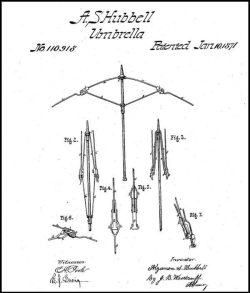
1871 Umbrella
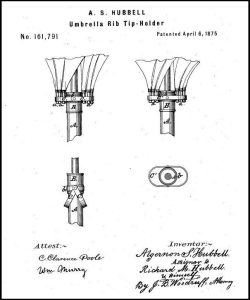
1875 Umbrella Rib Tip Holder
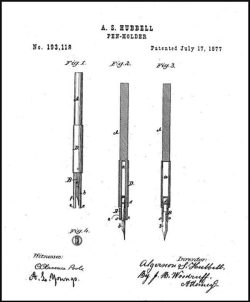
1877 Pen Holder
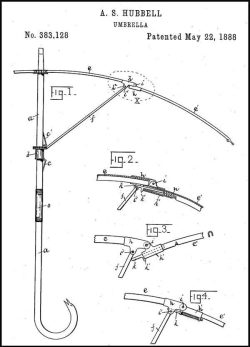
1888 Umbrella
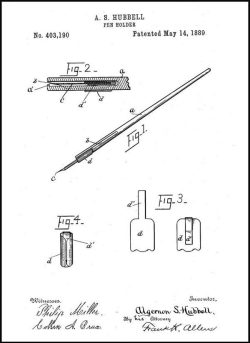
1889 Pen Holder
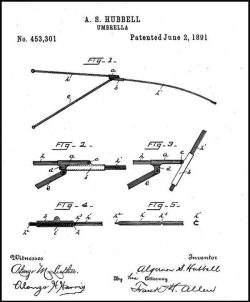
1891 Umbrella
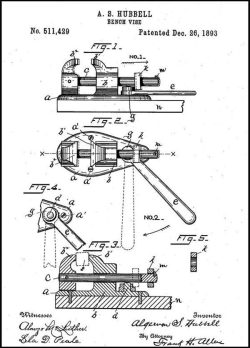
1893 Bench Vise

1899 Folding Umbrella
It is interesting to note the Algernon and his wife Lucretia lived next door (on Franklin Street) to John D. Crocker in 1872. Similar to Crocker, (and in the same time period) Algernon was an artist and inventor. Also, similar to Crocker, Lucretia, developed and sold a medication for stomach ailments.
Acknowledgements
FindAGrave.com
Ancestry.com
U.S. Patent Office
The complete list of sources may be found by clicking the “Bibliography” button, and, then typing “Algernon” in the SEARCH box.
The complete description of all his patents may be viewed by clicking the “Patents” button, and, then typing “Algernon” in the SEARCH box.
1909-1991 Edwin H. Land
Edwin Herbert Land was born in Bridgeport Connecticut on May 7, 1909, but lived in Norwich prior to his first birthday. Edwin attended public school and graduated near the top of his class from Norwich Free Academy in 1927. Two of his NFA teachers described him “as a genius.” He went on to study at Harvard, however, left after one semester to pursue his dreams. Over his lifetime he patented 535 inventions, more than any American except Thomas Edison and Elihu Thomson.
The story of Edwin H. Land and his family is a tale of success. His Jewish father, Harry M. Land, who was born in a small town outside of Kyiv Ukraine, immigrated to the United States at the age of three. By 1903, Harry and his wife lived to Norwich where worked for the Max Gordon & Son Corp., a scrap metal company. By 1934 Harry owned the Norwich-based scrap company and he also owned the Wauregan House.
Edwin lived with his family at 313 Washington Street, just a few blocks south of the Norwich Free Academy, throughout his high school years. Five years after graduating from NFA, he and his Harvard physics professor jointly established the Land-Wheelwright Laboratories. By 1937 the company was renamed to the Polaroid Corporation.
Seeking investors to help fund the development of his new camera, Land the spoke at Norwich’s YMCA about his new inventions and demonstrated his instant camera, which he named the Polaroid Land Camera. Previous to Land’s inventions, developing film required a long, involved process.
He is distinguished for his inventions and contributions in the fields of polarized light, photography and color vision. He had an impact on the lives of many millions of people and provided large-scale employment in many countries for over five decades. He mastered the art of giving the people what they wanted at a price they could afford. He has had few peers in the advancement and application of natural science to everyday life. Land’s achievements spanned the disciplines of art, science, technology and commerce.
In the field of polarized light, he was responsible for the invention, development and efficient commercial production of the first sheet polarizers, for a sequence of subsequent polarizers, and for the theory and practice of many applications of polarized light. Such devices are widely used today in liquid crystal displays, in sunglasses and in scientific and medical research. The trade name “Polaroid” has become the accepted generic name for these sheets.
Land’s lifetime achievements were innumerable. During World War II, he worked on military tasks, which included developing dark-adaptation goggles, target finders, the first passively guided smart bombs, and a special stereoscopic viewing system. Later, in the 1950s he helped design the optics of the revolutionary Lockheed U-2 spy plane. However, Edwin Land considered his leadership towards the development of integral instant color photography the SX-70 film and camera (shown on the left) to be his crowning achievement.
Two of Edwin Land’s Early Patents

1948 Polarized Film
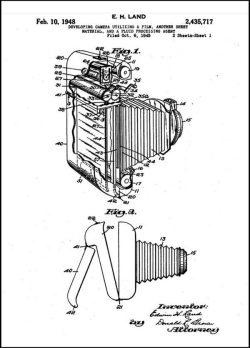
1948 Camera
Edwin Land’s ideas impressed Steve Jobs, the co-founder of Apple. In the Time magazine of 10/10/1999, Jobs wrote, “I’ve never believed that they’re separate. Leonardo da Vinci was a great artist and a great scientist … People bring those things together a lot. Dr. Land at Polaroid said, ‘I want Polaroid to stand at the intersection of art and science.’ I have never forgotten that.”
Norwich Free Academy’s library is named in honor of Edwin H. Land. The library contains a small museum of his artifacts.
He died in 1991 and is buried in Cambridge Massachusetts.
Acknowledgements
“From Humble Beginnings to Corporate Giant,” (02/23/2008), by Bill Stanley
“A Triumph of Genius: Edwin Land, Polaroid and Kodak Patent War,” (2015), by Ronald K. Fierstein
The Bulletin (02/23/2008), Richard Curland
Life Magazine (October 1972)
The complete list of sources may be found by clicking the “Bibliography” button, and, then typing “Edwin H. Land” in the SEARCH box.